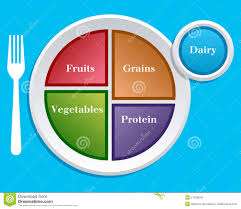K-State nutrition expert lauds the usefulness of the teaching tool; says everyone can benefit from it
MANHATTAN, Kan. – This month marks 10 years since the United State Department of Agriculture updated the federal symbol for nutritious eating to the now-familiar MyPlate graphic.
The move to replace the previous icon – the food pyramid – with the MyPlate concept caused quite a stir in the teaching and nutrition world, according to Sandy Procter, Kansas State University nutrition specialist. “It really changed the approach that we used with individuals and groups that were learning about eating healthier, and it has continued to evolve.”
The MyPlate symbol is the visual icon for the federal government’s Dietary Guidelines, which were recently updated.
The colorful plate image – divided four ways to show how much of a plate should be filled with vegetables, grains, fruits and proteins, with dairy represented as a cup next to the plate – represented important evolution in education about healthy eating.
Procter said the MyPlate symbol’s built-in flexibility allows it to remain relevant as research adds to our collective knowledge about the right kinds of foods and the right-sized portions we need to eat.
Even the recommended size of the plate – seven to nine inches in diameter, not the restaurant-sized plates that have become so common – helps identify the right amount of food we ought to eat.
“And then the proportion of food groups on that plate is very clearly laid out and talked about: Why it’s important; why there are more vegetables than fruits; and why there are more fruit and vegetables than grains and protein,” Procter said. “So that balance, in addition to the portion sizes that are outlined because of that plate size, really help us if we pay attention to eat not only a variety that’s healthy, but the amounts that are going to keep our weight in control.”
Procter offered tips and ideas that can make any plate as nutritionally balanced as it is interesting:
Fruits and vegetables
Procter said the idea that half the plate should be fruits and vegetables fits with the often-repeated refrain: Eat more fruits and vegetables. “Well, that shows up on the plate,” she said. “And not only does that show up on the plate, but in the Dietary Guidelines, it gets real specific talking about the brighter the colors and the more mix of variety that you can have in those groups, the healthier it’s going to be.”
Protein
“Even just varying the protein, whether we choose red meat, occasionally, poultry or seafood, or those plant-based protein sources … beans, legumes, there’s seeds, there’s nuts, there’s all types of foods that count as protein sources. And we really benefit from checking out what those can be, and how we can work a wider variety into our diets.”
Grains
“We still encourage people to make most of their choices whole grain. When we think grains, let’s think, instead of a white pasta, let’s think of a whole grain pasta, and making routinely a whole-grain bread choice. Rice can be whole grain.”
Dairy
“In the Dietary Guidelines, they really encourage us to look at sources of, particularly, fat-free and low-fat dairy. … And dairy itself has so many healthy properties and nutrients that really are much easier to get from that food group than any others.”
The USDA’s MyPlate website not only marks the 10-year anniversary, but also provides a range of new, interactive tools that incorporate concepts from the updated Dietary Guidelines.
“There are apps that appeal to different age groups, there are videos, there are all kinds of lesson plans laid out for both young groups and adults,” Procter said.
One such app allows users to enter information about themselves, learn how many calories they need and what kinds of food choices they can make, and track their eating. They can see how well they do compared to the MyPlate concept, the Dietary Guidelines, and their own personal goals as well as participate in seasonal challenges.
“There is truly so much that could be achieved if more Americans would follow the MyPlate or really what it represents: the Dietary Guidelines,” Procter said. “We know from the Healthy Eating Index, which is actually a measure of how well we eat toward the Dietary Guidelines, that very few Americans actually hit that level of eating appropriately through what the Dietary Guidelines say. … So we have a long ways to go.”
FOR PRINT PUBLICATIONS: Links used in this story:
• USDA MyPlate website: https://www.myplate.gov
• Recent K-State Research and Extension story about the Dietary Guidelines: https://www.ksre.k-state.edu/news/stories/2021/03/healthy-eating-important-at-all-life-stages.html
• Dietary Guidelines for Americans: https://www.dietaryguidelines.gov
• USDA Health Eating Index: https://www.fns.usda.gov/healthy-eating-index-hei
• Full audio interview with Sandy Procter on the Sound Living radio program: https://soundlivingksu.libsyn.com/a-healthy-plate-of-food
• An embeddable audio player of the Sound Living* radio interview for this story can be added using this code:
<enclosure url=”https://traffic.libsyn.com/secure/soundlivingksu/SL-061821L.mp3″ length=”7784033″ type=”audio/mpeg” ></enclosure>
* Sound Living is a radio program produced by K-State Research and Extension and is free to use and redistribute.
K State Research and Extension is a short name for the Kansas State University Agricultural Experiment Station and Cooperative Extension Service, a program designed to generate and distribute useful knowledge for the well being of Kansans. Supported by county, state, federal and private funds, the program has county extension offices, experiment fields, area extension offices and regional research centers statewide. Its headquarters is on the K State campus in Manhattan. For more information, visit www.ksre.ksu.edu. K-State Research and Extension is an equal opportunity provider and employer.
Story by:
Jason Hackett
785-532-5806
jhackett@ksu.edu
For more information:
Sandy Procter
785-532-1675
procter@ksu.edu





